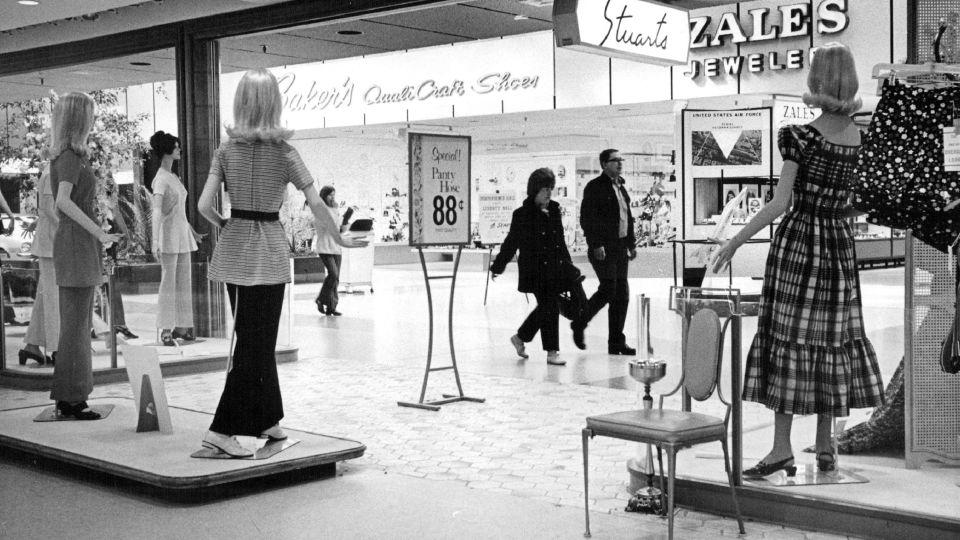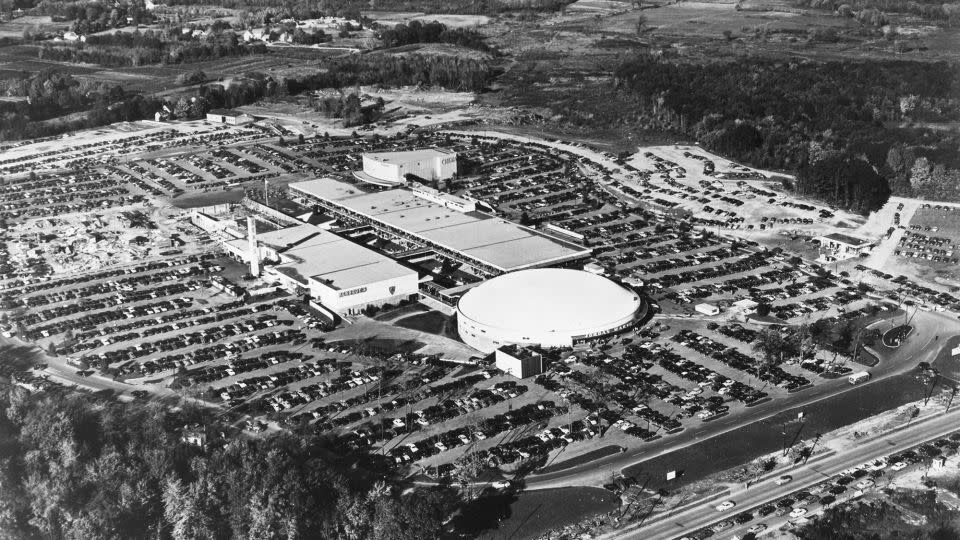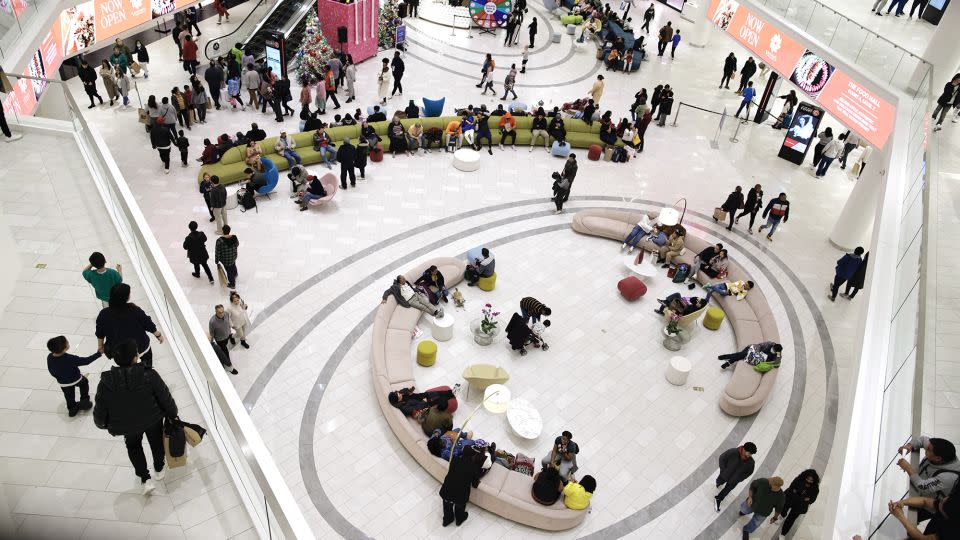The sneaky, smart reasons malls have no windows
Decades ago, Americans flocked to Main Street to shop. A string of small family-owned stores stood next to each other along a tree-lined block or two, displaying their goods through large welcoming windows.
Then in 1956 something happened that forever changed that shopping experience. A new retailing format packed up the hustle and bustle of Main Street commerce and recreated it inside of a very large boxy building that was – deliberately – devoid of windows.
The birth of the American mall ushered in an era of “windowless” shopping that’s largely still here. The strategy was clever and little details in the planning –- from the no-frills shoebox architecture to potted plants – were carefully thought out. These were cost-saving measures for mall operators that were also designed to influence mallgoers to spend freely. The unnaturally bright artificial lighting strived to create a perpetual daytime environment. This way, mall visitors would stay longer than they had expected to and spent more than they would have wanted to.
Another reason for malls shunning windows did have something to do with the merchandising, Burt Flickinger, retail expert and managing director of retail consultancy Strategic Resource Group told CNN.

Fewer windows and more walls, he said, meant more space for retailers to add shelves and rods to stock their products and maximize sales per square foot in their stores that would otherwise be lost to a dull view of a mall parking lot.
But the sneakiest reason why malls limit windows could be to make shoppers lose track of time.
“Shoppers can’t see the rain storm or snow storm blowing in without windows. Windowless shopping creates an environment of consumption without distractions,” Flickinger said. “When people have a sense of timelessness and comfort, families spend more because they can focus just on the stores and the mall experience.”
Shock-and-awe on the inside
The first fully enclosed mall – the Southdale Center in Minneapolis – opened in 1956. It became the prototype going forward as indoor climate-controlled malls that could stay open year-round popped up in suburbs across the country.
The architect of the 1.2 million square feet Southdale Center was Austria-born Victor Gruen, considered the pioneer of modern mall design. He established Gruen Associates, a legacy architecture, planning and landscape firm still in existence and based in Los Angeles.
He wanted to wow shoppers with shock-and-awe once they entered the building and took in the brightly-lit shops and cafes, even artwork exhibited around the mall.
At the center of the mall layout would be a fountain or a skylight, possibly the only entry point to natural light coming into the expansive space. He added plants and music to create an inviting sensory experience.

The structure of the traditional mall was either a T-shape, or a cross shape with the four anchor stores on either sides, Stephanie Cegielski, vice president of research with the International Council of Shopping Centers, told CNN.
“When you are walking around that ‘T’ everything is facing into you. As a shopper, you are perpetually looking at what is coming next and opposed to what’s going on in the outside world,” she said.
Because all of the activity faced in, Cegielski said it didn’t make sense for there to be windows per se, “unless you were looking at a department store that has its own separate entrance into the mall that would create that window to the outside,” she said.
The exterior look was another story. The Southdale mall was functional and drab to look at and that is the blueprint that all traditional enclosed malls have continued to follow.
“Malls are really built to have the landscape on the inside. All of the architectural energy that we normally see on the outside of a building in an urban setting is focused internally. A mall is a machine for selling,” Alexandra Lange, an architecture critic and author of “Meet me by the fountain: An inside history of the mall” said in an interview with CNN.

The first round of malls in the mid-to-late 1950s did have more architecture on the outside, Lange said. “But the mall owners found that there was no increase in consumer interest based on that so let’s not waste money on that,” she said.
Fewer windows means lower energy bill
As an added bonus, “it was a lot less expensive for mall developers to not put multiple windows facing on the outside because it would make it cheaper to heat and cool the big-box space,” said Thomas McMillan, director with the Center of Retailing Studies at Texas A&M University’s Mays Business School, in an interview with CNN.
Energy costs typically are the second-highest operating expense for retailers after labor costs. “The sophistication of double-pane energy-efficient windows wasn’t ubiquitous when a lot of the malls were built in America during and after the 1970s energy crisis. So air conditioning could seep through the window panes,” said Flickinger.
The mall design inspired another type of store. Other shopping destinations that incorporate a windowless boxy venue are supermarkets.
“A typical grocery store layout has all of the fresh food around the outside that tends to be refrigerated. It’s good for it to be next to a wall where there is power,” Lange said. “If you cut windows into the wall, you have less space for refrigerated cases.”
Today, there are about 1,122 enclosed malls in the US, according to the International Council of Shopping Centers. That’s down from around 1,400 regional malls that existed around 15 years ago, according to Kristin Mueller, president, retail property management with JLL, a real estate and investment management services firm, in an interview with CNN.

But even with fewer enclosed malls in existence today, and just a handful of new malls built over the last decade (including the 3 million square foot American Dream Mall which opened in East Rutherford, New Jersey in 2019) that still abide by Gruen’s blueprint, shoppers, especially Gen Z and Millennials, don’t appear to be put off by their windowless aesthetic, she said.
On average, 54% of US adult shoppers have visited a mall at least once a month in 2023 and spent an average of a little more than $300 each month last year, according to the latest data from the ICSC. As many as 70% of those shoppers were GenZers and 66% of them Millennials, according to the group.
Mall retailing is evolving, however, said Cegielski.
Families head to malls for entertainment as much as shopping, with people enjoying restaurants, movies, mini golf, pickleball courts and large indoor amusement centers that have been retrofitted inside of existing shopping centers.
Some of these adaptive uses of traditional malls might be creating a practical need for windows after all, she said.
For more CNN news and newsletters create an account at CNN.com

 Yahoo Finance
Yahoo Finance 